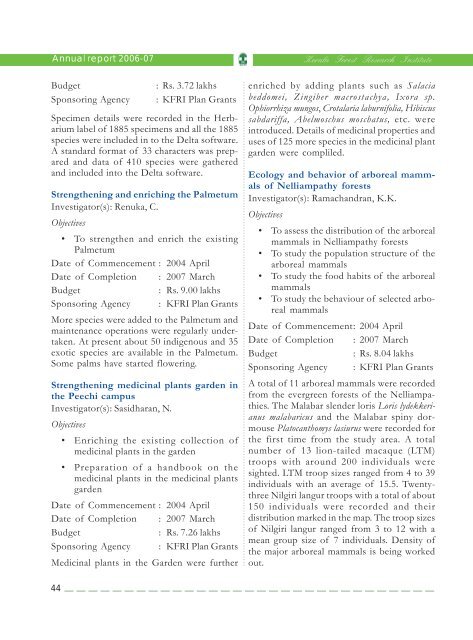2006-07 - Kerala Forest Research Institute
2006-07 - Kerala Forest Research Institute
2006-07 - Kerala Forest Research Institute
- No tags were found...
Create successful ePaper yourself
Turn your PDF publications into a flip-book with our unique Google optimized e-Paper software.
Annual report <strong>2006</strong>-<strong>07</strong><strong>Kerala</strong> <strong>Forest</strong> <strong>Research</strong> <strong>Institute</strong>BudgetSponsoring Agency: Rs. 3.72 lakhs: KFRI Plan GrantsSpecimen details were recorded in the Herbariumlabel of 1885 specimens and all the 1885species were included in to the Delta software.A standard format of 33 characters was preparedand data of 410 species were gatheredand included into the Delta software.....................................................................................................................................................................................Strengthening and enriching the PalmetumInvestigator(s): Renuka, C.Objectives• To strengthen and enrich the existingPalmetumDate of Commencement : 2004 AprilDate of Completion : 20<strong>07</strong> MarchBudget: Rs. 9.00 lakhsSponsoring Agency : KFRI Plan GrantsMore species were added to the Palmetum andmaintenance operations were regularly undertaken.At present about 50 indigenous and 35exotic species are available in the Palmetum.Some palms have started flowering.Strengthening medicinal plants garden inthe Peechi campusInvestigator(s): Sasidharan, N.Objectives• Enriching the existing collection ofmedicinal plants in the garden• Preparation of a handbook on themedicinal plants in the medicinal plantsgardenDate of Commencement : 2004 AprilDate of Completion : 20<strong>07</strong> MarchBudget: Rs. 7.26 lakhsSponsoring Agency : KFRI Plan GrantsMedicinal plants in the Garden were furtherenriched by adding plants such as Salaciabeddomei, Zingiber macrostachya, Ixora sp.Ophiorrhiza mungos, Crotalaria laburnifolia, Hibiscussabdariffa, Abelmoschus moschatus, etc. wereintroduced. Details of medicinal properties anduses of 125 more species in the medicinal plantgarden were compliled.Ecology and behavior of arboreal mammalsof Nelliampathy forestsInvestigator(s): Ramachandran, K.K.Objectives• To assess the distribution of the arborealmammals in Nelliampathy forests• To study the population structure of thearboreal mammals• To study the food habits of the arborealmammals• To study the behaviour of selected arborealmammalsDate of Commencement: 2004 AprilDate of Completion : 20<strong>07</strong> MarchBudget: Rs. 8.04 lakhsSponsoring Agency : KFRI Plan GrantsA total of 11 arboreal mammals were recordedfrom the evergreen forests of the Nelliampathies.The Malabar slender loris Loris lydekkerianusmalabaricus and the Malabar spiny dormousePlatocanthomys lasiurus were recorded forthe first time from the study area. A totalnumber of 13 lion-tailed macaque (LTM)troops with around 200 individuals weresighted. LTM troop sizes ranged from 4 to 39individuals with an average of 15.5. TwentythreeNilgiri langur troops with a total of about150 individuals were recorded and theirdistribution marked in the map. The troop sizesof Nilgiri langur ranged from 3 to 12 with amean group size of 7 individuals. Density ofthe major arboreal mammals is being workedout.44
















